
All categories
Featured selections
Trade Assurance
Buyer Central
Help Center
Get the app
Become a supplier

(2218 products available)


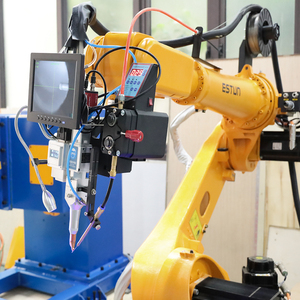



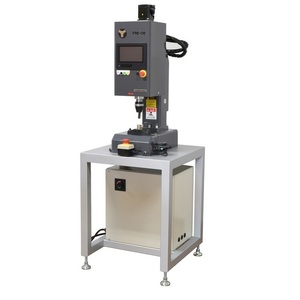




























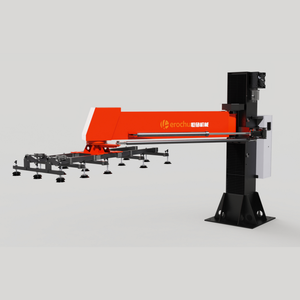



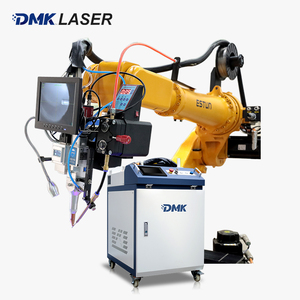

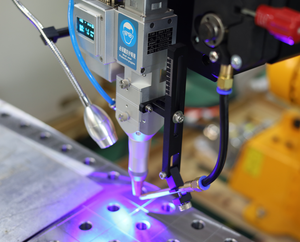



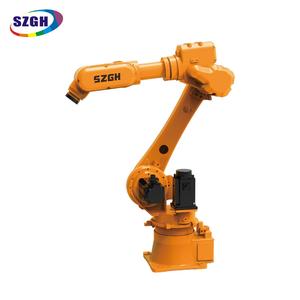

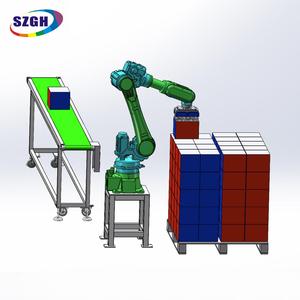

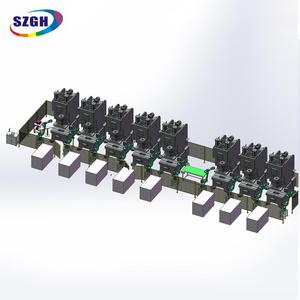

Automatic mechanical electric robot arms are widely used to handle materials. Buyers should select based on intended applications and load capacities. These are the main types.
These robots have several movable joints. They resemble a human arm in structure. Their complexity gives them a wide range of motion. This makes them ideal for tasks requiring precision. They handle intricate operations like welding and assembly. Their design also allows them to operate in confined spaces.
SCARA stands for Selective Compliance Articulated Robot Arm. These robots work well with lateral movements. They are suitable for assembly tasks requiring horizontal flexibility. They are also less effective at vertical movements. This limits their use in certain three-dimensional applications.
Delta robots have a unique design. They consist of three linked arms. These are all mounted on a parallelogram. The robots form a spider-like structure. It allows for high-speed operations. They are especially beneficial in packaging, sorting, and assembly tasks requiring speed and precision. Their lightweight design enables quick movements without sacrificing accuracy.
These robots feature a cylindrical-shaped joint. It provides up-and-down and in-and-out movements. Their structure gives them vertical extending abilities. Therefore, it makes them fit for assembly operations that require significant height adjustments. They are ideal for tasks involving heavy components. These include machining and assembly line operations.
These robots use a combination of two rotary and one linear joint. It gives them a unique spherical motion. Their design excels in handling heavy materials. That is why they are suitable for tasks requiring strong lifting capabilities. They work well in welding and heavy-duty assembly tasks. Their structure offers a different approach to movement compared to articulated robots.
There are various customization options for a robotic arm. Material and design modifications align with specific operational needs. Buyers can select the features below to optimize their performance further.
These enhance the arm's capability to perform complex tasks. Advanced sensors increase precision in material handling. They also enable the arm to adjust in real-time. This ensures safe operation even with fragile or irregularly shaped items.
These are essential for adapting to diverse materials. They range from soft rubber grips to heavy-duty claws. Each type of gripper is suited for specific material types. They include delicate packages or bulky containers. Customized grippers enable the arm to securely handle a wide variety of products. This minimizes the risk of damage during transport.
They include programmable logic controllers and AI-based systems. They offer buyers flexible operation modes and integration capabilities. These control systems allow for quick task reprogramming. This makes them ideal for rapidly changing production needs. They also enhance system coherence. This leads to more efficient operations in complex environments.
These options are crucial for specific handling requirements. They include vacuum suction cups and magnetic pick-and-place tools. Each end-effector type is designed for a particular application. These may be heavy items in industries such as manufacturing or more delicate ones in logistics.
These allow the robot to reach greater heights or tighter spaces. Buyers normally request this when handling large pallets or navigating narrow aisles. Customized arm extensions offer the additional reach or flexibility needed for specialized tasks.
Understanding the specifications and maintenance requirements of robotic arms is essential for optimizing performance and longevity. Below are the key details for these aspects.
Load Capacity
This is the maximum weight a robot arm can handle. These arms are available with different load capacities. They range from a few kilograms to several hundred. Heavy-duty arms are ideal for handling bulky or dense materials in challenging environments. Light-duty ones are suited for smaller, more delicate items.
Degrees of Freedom (DoF)
This refers to the number of joints or axes of movement. Higher DoF models offer more complex and versatile movements. Articulated models usually have 6 or more DoF. SCARA and cylindrical models have 4 only. These robots are ideal when intricate or multifaceted handling tasks are a must.
Speed and Acceleration
These are key performance indicators. Speed is assessed in terms of motion for specific distances per minute. Acceleration increases speed over time. Faster models enable quick handling in high-demand settings. Yet, slower ones afford more careful, detailed work in low-volume environments.
Control System
Robot arms practically come with different types of controllers. They include conventional ones, AI-integrated, and PLC-based. Each control method has its advantages. For example, AI controllers truly enhance flexibility and autonomy in dynamic environments. Traditional systems, however, ensure simple, user-friendly operations in more predictable pipelines.
Regular Inspection
Users must conduct routine, in-depth examinations of all arm components. These include joints, sensors, and grippers. This enables them to identify possible wear, tear, or malfunction early enough. Additionally, it ensures optimal performance at all times.
Lubrication
Lubricating movable parts reduces friction and associated wear. Buyers should, however, only apply manufacturer-approved lubricants. Doing so ensures compatible with the arm's components. Over-application can cause grime buildup. This may impede the robot’s functionality.
Software Updates
Software updates are necessary to enhance the arm's performance. These updates fix previously detected bugs and add new features. The old systems' users must ensure they update their software regularly. They should also back up data before installing new updates. It prevents them from losing crucial data in case of a system failure.
Calibration
It ensures the arm performs its intended tasks accurately. Users should frequently calibrate their arms. It is especially important after heavy or extended use. Regular calibration also improves consistency in handling tasks.
Integrated Maintenance
Users should incorporate maintenance into their daily operational activities. This gives room for practical examinations and repairs without interfering with productivity. Integration of maintenance also reduces unplanned downtimes. This leads to increased operational efficiency.
When purchasing automatic mechanical robotic arms, buyers should contemplate the elements below. Each aspect significantly impacts operational efficacy, long-term dependability, and total return on investment.
This determines how much weight an automatic arm can handle. Buyers should go for arms with suitable load weight capacities. Normally, these arms are manufactured to lift material loads of different weights. From light ones like boxes to heavier ones like crates. It is, therefore, crucial that they consider the heaviest items their robots will be lifting. This ensures the selected robotic arm can handle maximum weights with ease.
Robotic arms usually come with various control systems. They range from simple manual to advanced programmable ones. Buyers should ensure the operating systems of their arms are compatible with existing infrastructure. A mismatch could lead to prolonged downtimes or the need for additional investments. Compatibility also helps in integrating the arms into current workflows. This quickly gets them up and running.
This is a key consideration for clients who prioritize accuracy in their operations. It is particularly crucial in industries like manufacturing and logistics. Robotic arms come with different precision levels. High-precision arms, though, are ideal for delicate handling tasks. Go for arms featuring advanced sensor technology to further improve accuracy. They enable the arm to adjust in real time. This ensures consistent performance across various applications.
Durability directly affects long-term operating costs. Buyers will be required to spend a lot on repairs and replacements for less durable arms. They should prioritize models constructed from high-quality materials. These include metal alloys and reinforced composites. These arms are able to withstand the mechanical wear and tear that accompanies continuous use. Also, ensure the arm is resilient to the specific working conditions in the environment. It enables the arm to perform optimally in challenging situations.
Budget is an important factor for any buyer. Robotic arms are available at different price levels. For instance, high-end models loaded with advanced features normally cost more. While the initial cost is important, the total cost of ownership must also be factored in. It includes maintenance, repairs, and energy consumption costs. Buyers should consider the return on investment potential of the arm. Going for an efficient arm with low operating costs will, in the long run, pay off.
A1. The 5 key components of a robot arm are the controller, end effector, sensors, power supply, and actuator. The controller runs the arm, while the end effector performs tasks. Sensors collect data on the environment or operation. The actuator enables the arm to move, and the power supply gives the arm its required energy.
A2.Robot arms offer speed, accuracy, and efficiency. They carry out repetitive tasks without getting tired, unlike humans. This boosts productivity a great deal. They are also capable of managing complex and delicate items. Doing this reduces the risk of injuries and damages. Their versatility enables them to be used in different industries. From manufacturing to logistics.
A3.Load capacity directly impacts a robot arm's purchase decision. One, it determines the type of material the arm can handle. Also, arms with higher load capacities are more versatile. They can manage lighter and heavier items. Giving them the flexibility to be deployed in various tasks. This makes it crucial for clients to match the arm's load capacity to their specific operational requirements.
A4.Robotic arm manufacturers normally use high-quality materials to make them. The most common one is metal alloys. They include steel and aluminum. These materials offer great strength and durability. Some manufacturers also use reinforced composites. They are lightweight and resilient. Less sturdy materials like rubber are used for grippers. It gives flexibility and better grip on the items being handled.
A5.Yes,robotic arms are normally manufactured with various customization options. Buyers normally request for control and end-effector systems modifications. They do this to suit their unique operational needs. Custom grippers, for example, can handle a wider variety of materials. While personalized control systems improve the arm's precision and efficiency. Buyers can adjust the arms by selecting their preferred sensor types and speed ranges. This makes them suitable for specific applications.